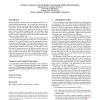Free Online Productivity Tools
i2Speak
i2Symbol
i2OCR
iTex2Img
iWeb2Print
iWeb2Shot
i2Type
iPdf2Split
iPdf2Merge
i2Bopomofo
i2Arabic
i2Style
i2Image
i2PDF
iLatex2Rtf
Sci2ools
IMC
2009
ACM
2009
ACM
Triangle inequality variations in the internet
Triangle inequality violations (TIVs) are important for latency sensitive distributed applications. On one hand, they can expose opportunities to improve network routing by finding shorter paths between nodes. On the other hand, TIVs can frustrate network embedding or positioning systems that treat the Internet as a metric space where the triangle inequality holds. Even though triangle inequality violations are both significant and curious, their study has been limited to aggregate data sets that combine measurements taken over long periods of time. The limitations of these data sets open crucial questions in the design of systems that exploit (or avoid) TIVs: are TIVs stable or transient? Or are they illusions caused by aggregating measurements taken at different times? We collect latency matrices at varying sizes and time granularities and study dynamic properties of triangle inequality violations in the Internet. We show that TIVs are not results of measurement error and that the...
| Added | 28 May 2010 |
| Updated | 28 May 2010 |
| Type | Conference |
| Year | 2009 |
| Where | IMC |
| Authors | Cristian Lumezanu, Randolph Baden, Neil Spring, Bobby Bhattacharjee |
Comments (0)

